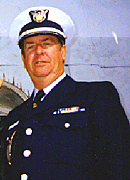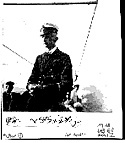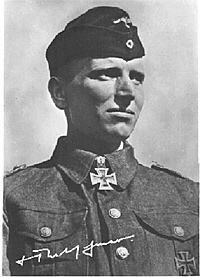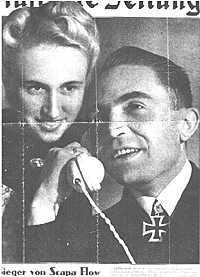 This is the interview conducted by MIKE MATHIS (6063-2000) and produced by ROB LIHANI’s Digital Ranch (5989-2000) in 2000 when their cameras went to Germany with HARRY. Here are his thoughts on the war at sea.
This is the interview conducted by MIKE MATHIS (6063-2000) and produced by ROB LIHANI’s Digital Ranch (5989-2000) in 2000 when their cameras went to Germany with HARRY. Here are his thoughts on the war at sea.
SHARKHUNTERS: What is your connection to SHARKHUNTERS?
COOPER: I’m the founder and president of SHARKHUNTERS International.
SHARKHUNTERS: When did Germany begin the production of U-boats?
COOPER: Germany actually began production of U-boats before signing the London naval agreement. They were producing them in secret in the Netherlands under an umbrella company that was put together by the German manufacturers and the German navy. They were allegedly making submarines for the navy of the Netherlands and various other navies, although they never did quite get them out of sea trials, they just kept trying them and trying them and - keeping control.
SHARKHUNTERS: Why and when did this really take off?
COOPER: I believe they were making these U-boats in secret to maintain the technological edge in U-boat construction prior to Hitler abrogating the Treaty of Versailles. They actually had German boats in combat in 1936 during the Spanish Civil War. They had several U-boats off the Spanish coast, actually attacking Franco’s enemies.
 SHARKHUNTERS: Who was Dönitz, and what was his plan for U-boat warfare?
SHARKHUNTERS: Who was Dönitz, and what was his plan for U-boat warfare?
COOPER: Admiral Karl Dönitz had been a submarine commander during World War I, and he had envisioned large scale, wolf pack type attacks. He felt that the German boat was not fully utilized in World War I. In World War II he was commander of the submarine force. He started out as Kapitän zur See (Navy captain), and he decided to build the wolf packs for maximum efficiency against convoys.
SHARKHUNTERS: What sort of man and commander was Dönitz?
COOPER: From everything I’ve been able to learn from the U-boat veterans I know, Admiral Dönitz was highly regarded by his commanders. He knew everyone by name. When he was based at Lorient, he would always come down and greet each boat coming back. He knew each man, he knew his family situation, and there’s almost nobody that has a bad word about him.
SHARKHUNTERS: What is a wolf pack and the U-boats function in the war?
COOPER: The U-boat initially was meant to cut the supply lines to Great Britain. One U-boat by itself really wasn’t very effective, so he hit on the idea or he finalized the idea of the wolf pack.
SHARKHUNTERS: What was the wolf pack and what was Dönitz plan?
COOPER: Admiral Dönitz was going to use the U-boats to cut the lifeline to England. England couldn’t survive very long without supplies coming in from elsewhere. Admiral Dönitz felt that if he could group a large number of submarines into the path of an oncoming convoy, he could decimate the convoy. So the U-boats were pretty well strung out in, like a picket line off the western approaches to Great Britain. When one U-boat would spot a convoy, he would radio back to headquarters and he was not allowed to attack. He had to shadow the convoy and keep reporting its course, its speed, any course changes, etc. Meanwhile, Admiral Dönitz’s headquarters at Lorient, actually, Kerneval, the next town over, they would put together a wolf pack, knowing the position of all the various U-boats in the area. And then they would form a solid line in front of the convoy, and then they were allowed to attack.
SHARKHUNTERS: What kind of men sail German U-boats?
COOPER: Well, there’s actually two different questions there. The men who volunteered were basically very patriotic, very driven young German men that joined the Navy. They were non-political. As a matter of fact, in the Navy, they were not allowed to belong to any political party. So that was the type of man who volunteered. The type of man who was accepted was the best of the best. The best radio operators, the best mechanics, etc. which is why after the war was over, those veterans who were still living, succeeded so well in business after the war, because they were excellent young men.
SHARKHUNTERS: Was there a certain type of personality?
COOPER: It takes a very special person to serve on any submarine. Germany boat, American submarine, etc. A person who serves on a submarine has to be a team player. It’s no place for individuals. And it’s a person who has to know his job thoroughly, because if one person fails in his job, the whole boat is lost and everybody dies. So everyone has to be a member of a team, everyone has to have complete faith and trust in the other guy. Many of the U-boat commanders and veterans all kind of subscribe to Admiral Lord Nelson’s theory that they were all a band of brothers.
SHARKHUNTERS: How successful were U-boats in the early years and why?
COOPER: In the early years of the war, the U-boats were extremely successful. I think part of the reason was that England had no defense for them. They were able to hit individual ships, and then when England went to the convoy system, the destroyer skippers were not really schooled in antisubmarine tactics. It was only after Commander Johnny Walker took over command of, I think it was Escort Group Five, and some U-boats were attacking and he asked his destroyer skippers ‘What are you doing about this?’ And their response basically was ‘Well, what can you do?’ And so, Johnny Walker devised some very successful antisubmarine tactics in which the destroyers would basically peel off from the convoy and swing around to the rear of the convoy to catch the submarine after the convoy had passed over it. Then they started getting more effective. But it wasn’t until much later that the U-boats were really threatened. In the early years of the war, they still had plenty of targets. When the British got really good at convoy protection, they came over to the United States where there was absolutely no convoy protection, and the ships were sunk like sitting ducks along the American coast, in the early 1942.
SHARKHUNTERS: What were the glory years of the U-boat?
COOPER: Well, the early years were actually called the Happy Times by the Propaganda Kompanie, which was a term most U-boat skippers are not happy with because they did lose a lot of their buddies. They lost a lot of submarines - even in the early years, not as bad as the later years. But they found plenty of targets. Antisubmarine was not really perfected, the radar was not much of a threat in the early years, the codes were not broken yet. The high frequency directional finding, which is called HuffDuff, had not come into effect. Along the American coast, there was no convoy system. Admiral King seemed more interested in building carriers and battleships, than he did in protecting the convoys. The Royal Navy would express concern and displeasure that they would get a convoy all the way over to the United States, only to turn it over to the U.S. Navy that was not prepared for antisubmarine work, and then lose a lot of ships right in sight of the American shore. So the early days of the submarine warfare were quite successful. And off the American East Coast, their skippers referred to it as the American Shooting Gallery, because they really did not have much of a defense. When the United States Navy finally started getting tougher in about June of ’42, then the U-boats were shifted down to the Caribbean, where Admiral Dönitz figured that it would be much safer, and it was. When the antisubmarine forces went down to the Caribbean, he shifted them back up to the American East Coast. So up until what they call Black May of 1943, it was not a bad time for the subs.
SHARKHUNTERS: What is life like for a sailor of a U-boat?
COOPER: Life on board a U-boat, for the average sailor, varied depending on the type of patrol. Some patrols were one or two weeks long, and it wasn’t too tough. Other patrols would last, oh, I think the longest one was like, two hundred twenty days. They were confined to this little tube, they never saw the sunlight. They had no officer’s wardroom or a sailor’s wardroom like on an American submarine. They ate either at their bunk or at their duty station. They hot bunked, which means there was one bunk for every two sailors. One guy would be on watch, and the other guy’d be sleeping. And when the watch would change, one guy would tumble out of bed and the other guy would tumble in. The bed would still be warm and wet, and rather smelly. The food was quite good; they got the best food of any of the services. But after about two weeks they were eating canned food again. Fresh water was almost nonexistent for the guys because they had desalinators, which would only produce enough water to replace the battery water everyday. They were allowed about one glass of water to brush their teeth and that’s it.
SHARKHUNTERS: Why didn’t they see the sunlight?
COOPER: U-boat sailors didn’t see the sunlight because their job was down inside the submarine. Even when they were running surfaced, the only ones to see the sunlight would be the Skipper, the officer of the watch and the lookouts. If they had gun action, then the gun crew would come up. The torpedo mechanics never saw the sun, because they were in the torpedo room. The engine mechanics were back in the diesel room, etc. Their job was inside the sub, so they would go weeks, months at a time without ever seeing the sun.
SHARKHUNTERS: Did they bathe and shave?
COOPER: U-boat guys, as you’ve seen in all the wartime movies, almost never shaved. One of the reasons was because they didn’t have water. Another reason was because they were young guys, and this was their statement of manhood, I guess. There were no showers on any U-boats, except some of the guys were a little more creative, and they would devise their own showers. U-67 had an actual showerhead that they would rig up on the conning tower, and if they were in a safe area, they would get up on the surface, and the guys would come up in small numbers and shower. Other submarines would tap into the cooling water outlet behind the diesel engines, and they could squat down behind the engines, and take a warm saltwater shower. I guess it was better than nothing. The big boats that would go to the Indian Ocean had a rather safe time of it, because there was very little antisubmarine activity in that area, so the skipper would find a rain squall and run underneath the rain squall, and the guys would run up on deck in small numbers with a bar of soap, scrub down, and then go below, the next group would come up. It was a tough life. They had no air conditioning and they had no heat on the submarines. If they were operating in the Arctic, the temperature of the water outside set the temperature of the water inside. So everybody would work, sleep, eat in their heavy clothing, to stay warm. If they operated in the Caribbean, they would generally be running around in their skivvies, because it was so hot. They had no air conditioning and no heat.
SHARKHUNTERS: Describe how a u-boat or wolf pack attacks a convoy.
COOPER: To describe how a wolf pack would attack a convoy is not such an easy answer, because it was not really specific.
SHARKHUNTERS: Describe the instructions that they follow.
COOPER: During a convoy attack by a wolf pack - after the boats had closed on the convoy, generally they would try to attack at night. Almost all the attacks were night surface attacks. Some of the U-boats would scatter around the convoy and fire from outside. Some of the guys, like Kretschmer, would deliberately get inside the convoy to where it was almost impossible to attack him. He would run on the surface, fire one torpedo for one ship. There were even times he would use his deck gun inside a convoy to sink ships. The method of attack depended on the particular Skipper. Some guys liked to attack from outside, some guys liked to duck the escorts, going behind them and shoot at the outside of the convoys. There were certain types of torpedoes that were designed to go into a convoy in a straight line, and then start looping in a figure eight, and they would hit something. U-boats, the Type VII boats had four tubes forward and one tube aft. The Type IX boats, which were the longer-range subs, had four tubes forward and two tubes aft. They carried a certain number of reloads, of course, inside the sub and some of them outside. While they were firing at a convoy and expended their forward torpedoes, they would generally turn around, saving the rear torpedo in case a destroyer was chasing them, retire to a safe distance, reload the forward tubes from the stored torpedoes in the forward room, go back into the convoy again. They never tried to reload from the externally stored ones unless they were in an extremely safe area, because with the hatches open, the submarine is very vulnerable. Some convoy battles were over within hours, others would take days.
SHARKHUNTERS: Can you aim a torpedo?
COOPER: Torpedoes can be aimed. The submarine does not have to be pointed at the target. They set the gyro angle so that the torpedo will take a certain direction after it leaves the tube, and that way they can lead a ship. They estimate the speed, the distance, they got their little early stage computers, and they can fire at a particular ship, at a different direction from the submarine.
SHARKHUNTERS: Did the torpedoes leave wakes behind them?
COOPER: The early torpedoes would leave a wake. They were steam-powered torpedoes. Then the Germans came out with an electric powered torpedo that left no wake, and it was virtually impossible to figure out where the torpedo came from unless they were able to see the submarine, which was next to impossible in a night surface attack.
SHARKHUNTERS: How many torpedoes did a Type VII have?
COOPER: The Type VII sub, which is basically the ones you see in all the so called wolf pack movies, had five tubes, and each tube was fully loaded when it left port. Then they would hang other torpedoes inside and a few outside. The Type VII could carry a total of about sixteen torpedoes. The Type XI could carry about twenty-two.
SHARKHUNTERS: What did convoys do to protect themselves?
COOPER: Again, in the early years during convoy battles, the merchant ships themselves would never try to chase down a submarine. They eventually started arming the merchant ships with three-inch guns, five-inch guns, etc., but they were not so effective against the submarine because the submarine could dive and a gun has no effect on them. So the convoy would continue, the destroyers would peel off. In the early days, they couldn’t stay with the hunt very long as they had to get back to the convoy and try to protect them from other submarines. Later in the war, when they had the hunter killer groups, they would have convoy escort stay with the convoys all the way. And then they had the hunter killer groups that would break off and would chase down the submarine if it took two days, three days, whatever, they would stay right with it until they killed it.
SHARKHUNTERS: How did the destroyers kill submarines?
COOPER: Generally a destroyer attack against a submarine would be with depth charges. They would pin point them with sonar, go over the spot where they thought the submarine was, and drop depths charges. They would set them for various depths, and if they went off within twenty-five feet of a submarine, it blew a hole in the hull and killed it. Within fifty feet or so, would do some damage. Other than that, they escaped.
SHARKHUNTERS: Who were the submarine Aces and why?

 OTTO KRETSCHER (122-+-1985) on the left, with his Knights Cross and Oak Leaf. Günther Prien (right) as seen on the cover of many world magazines after his sinking of the battleship HMS ROYAL OAK. The caption that appeared in LIFE Magazine at the time was: “Hello mother. I just sank a battleship!”
OTTO KRETSCHER (122-+-1985) on the left, with his Knights Cross and Oak Leaf. Günther Prien (right) as seen on the cover of many world magazines after his sinking of the battleship HMS ROYAL OAK. The caption that appeared in LIFE Magazine at the time was: “Hello mother. I just sank a battleship!”
COOPER: The definition of a submarine Ace is somewhat nebulous. It’s not like a fighter pilot where you shoot down five enemies and you become an Ace. I think actually an Ace would describe some of your top Skippers. In the early days, of course, it was Kretschmer, Schepke and Prien. They were the top three Aces because they were sinking the most tonnage. Then in the same convoy battle, they lost all three of these guys. The 7th of March, 1941, Prien was sunk, and then following the same convoy toward England on the 17th of March, Schepke and Kretschmer were then sunk. So there was not a specific number of ships or number of tons required to sink to become an Ace. There were specific guidelines to winning a Knights Cross in the early stages. But basically I think a U-boat Ace was somebody who excelled at sinking ships.
SHARKHUNTERS: Tell me about the battle where these Aces were lost.
COOPER: The three top Aces, Kretschmer, Prien and Schepke were part of a wolf pack that was attacking a convoy coming toward England. Initially it was thought that the destroyer HMS WOLVERINE sank Prien’s U-47. But later details find that it was actually a circular run of his own torpedo that sank him. HMS WOLVERINE was on the other side of the battlefield, and he was actually attacking a different submarine. Later on, on the 17th of March, Schepke’s boat, U-100 was attacked and rammed by HMS VANOC. They recovered about half the crew. Within a few hundred meters of that spot, HMS WALKER stumbled upon U-99 under Kretschmer and began a depth charge attack. As sheer fate would have it, the last depth charge that HMS WALKER dropped was the one that hit a fatal blow to U-99. They came to the surface. All but three men got off the boat and were captured.
Part 2: Harry Cooper Interview
Back to KTB # 158 Table of Contents
Back to KTB List of Issues
Back to MagWeb Master Magazine List
© Copyright 2002 by Harry Cooper, Sharkhunters International, Inc.
This article appears in MagWeb (Magazine Web) on the Internet World Wide Web. Other military history articles articles are available at http://www.magweb.com
Join Sharkhunters International, Inc.: PO Box 1539, Hernando, FL 34442, ph: 352-637-2917, fax: 352-637-6289, www.sharkhunters.com
